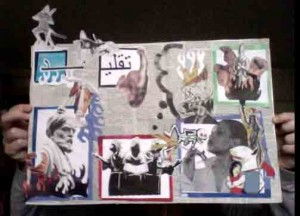Little Hells
In the graphic novel workshop, we discussed the many artistic layers of Arabic calligraphy and how both ancient artists and modern graphic novelists manipulate calligraphy into pictures to draw out symbolism or tell a multi-layered story. We also discussed the use of the “gutter” or the space between panels as a tool to allow the reader to draw his own conclusions about what happens between panels. The most striking theme of the workshop was the unique way in which comics can convey time and space; as the workshop leader illustrated, one cannot see all of the scenes of a movie or hear all of the notes of a song simultaneously, but comics allow the reader to focus on all or one portion of a story and the author to direct their eye.
Employing the strategies I learned, I have created a comic depicting the idea of the simple message of God (in this case, the idea of Hell) can be interpreted in a variety of cultural and geographical contexts or tailored to fit an ideology or agenda.
Here, I saw the Arabic word for tradition or imitation forming a picture that goes from simple to chaotic, representing the simplicity of how I imagine God’s intended message, and how it can be complicated by human interpretation, bias, and culture. The “simple” end of the word extends beyond the gutter from Heaven into the human realm where the perceptions of Hell are being created. From our readings, I drew out four major perceptions or ideas about the nature of Hell.
First, and most descriptive was the Swahili view, which described a very physical hell existing to punish sin justly. To an outsider, this view had clear male-centric and anti-Semitic undertones. Second is the notion of separation from God in a physical sense as being Hell. The third is the separation from God in a spiritual sense, allowing modern or western ideas to infiltrate purity. The last is the idea of fear and self-centrism as Hell, as suggested by the story of Rabia, who carried water to distinguish hell and a torch to set fire to Heaven to remind people that true devotion to God should not be motivated out of fear or selfishness.
I gave each of these ideas their own panel and make use of the unique expression of time offered by comics to demonstrate that these ideas about Hell are occurring simultaneously even if we choose to subscribe to or focus on a particular one. Each hell extends beyond the gutters to interact with other perceptions of hell at times, informing the reader directly what is occurring between panels. The newspaper background demonstrates how words, whether through ancient oral tradition, books, or modern media connect these various viewpoints and allow them to interact across time and geography.
I chose collage as a medium to as a parallel to the message behind this piece; to convey the way people create new pictures and meaning out of existing material they have and understand.
